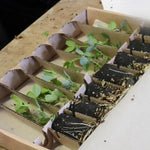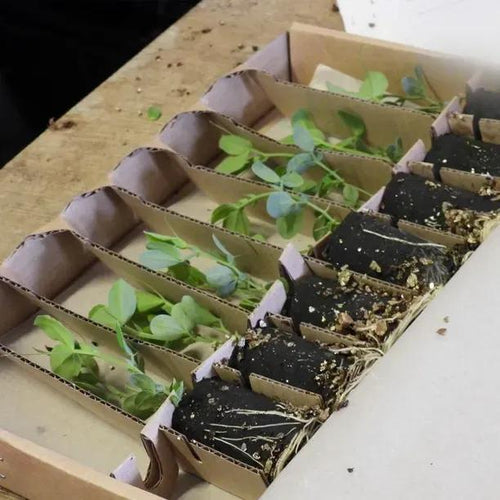Pink Pearl Sweet Pea Plants
Pink Pearl is an annual sweet pea in the prettiest, softest shade of pink. It opens from white buds with just a touch of pink to a lovely flower with delicately waved petals and a rich perfume, a classic Spencer type, on long, strong stems. Like all sweet peas, Pink Pearl needs a good support network to clamber up. Provide this in the form of a wigwam of canes or hazel, a tall obelisk or a pergola. Do tie or wind in the shoots to begin with to help plants get a good hold, then they'll romp away. Pink Pearl will flower from June to September, or even later if you make sure it doesn't set seed. Pick the flowers to bring indoors – its long, strong stems mean it works well in vases. As the flowers on the plant fade, deadhead them, and you'll be rewarded with an even longer display.
Not to be confused with the perennial sweet pea that's also called 'Pink Pearl'.
Browse our range of sweet pea seedlings.
Our Sweet Peas are delivered in purpose-designed, recycled cardboard packaging, and are ready to be planted out when you get them.
We generally send them out between March and May, but we will email you with the likely delivery timescale once you have placed your order.
Features
- Colour: pastel pink
- Stem: long
- Height: 1.8m
- Type: Spencer
- Scent: strong
- Flowering: June to September
- Planting Months: March-June
Growing
A border full of colourful sweet peas is a sight to see, and the scent will knock your socks off, too. Pastel colours like Pink Pearl look great with other cool pinks, purples and blues, such as lavender blue Our Harry. Or try growing it with pale pink and lilac Turquoise Lagooon: it's a match made in paradise. Always find them a sunny spot, and keep them really well watered (this is the trick to avoiding mildew). In dry weather, a good soaking in the evening is the best way to do this. Of course sweet peas combine wonderfully with any of the classic English garden favourites, such as lady's mantle, roses, lupins, lavender and cosmos, to create a rich tapestry of colour and scent in beds and borders. You can grow annual sweet peas in pots, too. There are a few rules you need to follow, the first being to never let the pots dry out, and the second being to start off with good, rich compost, and feed during the flowering season. Obviously, they'll need supports to climb up. Finally, a wigwam of sweet peas in a vegetable bed is a good idea. It'll attract pollinators, look gorgeous and quite possibly fix nitrogen in the soil (see below).
History & Trivia
We've long believed that the root nodules in pea and bean plants 'fix' nitrogen in the soil. In an episode of Gardeners' Question Time, Chris Beardshaw said that in fact only about 3% of the sweet pea's nitrogen remains once the plant has flowered (leguminous roots don't start sharing their nitrogen until the plant die back or are pruned). Still better than nothing!

 Secure, One-Tap Checkout
Secure, One-Tap Checkout
 Hand Picked, Delivered to Your Door!
Hand Picked, Delivered to Your Door! 1 Year Bareroot Guarantee
1 Year Bareroot Guarantee






